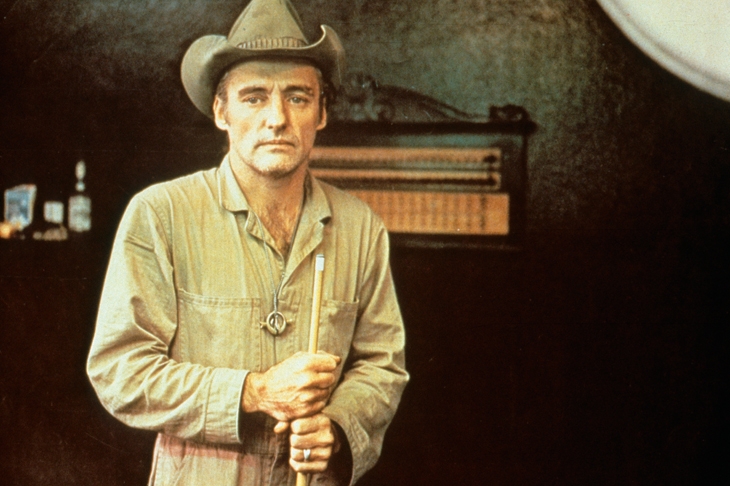What know they of movies who only movies know? Wim Wenders’s latest collection of essays arrives at a time when the best-known film critic in England is unashamed to claim that tendentious tosh The Exorcist as the best picture ever made. Even though the slightest piece in The Pixels of Paul Cézanne is its title essay, it is good to know that there is still at least one film buff around who is alive to the first six arts.
As a young man in Dusseldorf, Wenders fancied himself a painter — so much so that, before the movies lured him away, he was planning to further his studies in Paris. So while he tells us nothing about Cézanne’s work that Meyer Schapiro hadn’t filled us in on way back when, there can be little doubt that Wenders knows his way around an image. I can’t say that his essay on Andrew Wyeth did anything to change my mind about that gothic puritan dullard. But there is no gainsaying Wenders’s insight that ‘Edward Hopper does not paint close-ups — something he has in common with John Ford’.
That claim comes from a piece originally published in Die Zeit in 1996, but Wenders was a Hopper-long kid long before that. There is barely an image in The American Friend — Wenders’s take on Patricia Highsmith’s Ripley’s Game — that doesn’t have its origins in one of Hopper’s canvases. The orange that frames or slices through pretty much every scene in the movie is borrowed from the petrol pumps in Hopper’s ‘Gas’. The low-slung, wide-angled Hamburg cityscapes pay homage to Hopper’s canvases such as ‘Nighthawks’ and ‘New York Office’. And the movie’s big murder scene, set on a train rushing through the German countryside, is lit and composed just like the surreally frozen lounge in Hopper’s ‘Western Motel’.
Not that we are dealing with a mere image-maker. Pauline Kael once said that Wenders liked stories even though he was no good at telling them. The truth is, Wenders is so good at stories he can see them everywhere. To most modern eyes, Hopper’s ‘Rooms by the Sea’ is a collocation of coloured triangles and trapezoids so subject-free it looks forward to the post-painterly abstractions of Kenneth Noland and Richard Diebenkorn. To Wenders’s eyes it is the study of a suicide out of James or Melville:
Someone has just leapt out of the open door… into the sea, whose waves are billowing directly below the threshold of the room, as if this house was built on a cliff or standing on stilts… And the next minute a boat will appear in the distance on the horizon, too far away to fish out the person who has thrown himself (or herself?) into the infinite sea.
Wenders being Wenders, the book isn’t all paintings. Many of his filmic father figures — Bergman, Sam Fuller, Antonioni, Douglas Sirk (deliciously labelled ‘the Dante of Soap’) — are here too. Wenders is good on Anthony Mann’s psychologically inflected Westerns of the 1950s. Once again the comparison is made with John Ford, with Wenders arguing that while Ford’s oaters give us a ‘formidable, mythical America, shining through to us from the past’, Mann’s offer up a landscape that’s ‘realistic, valid, present through and through’. Once again he spots stuff even the most seasoned aficionadoes have missed — such as the way Mann’s images remain in focus all the way from near to far.
Then again, so what? Too often Wenders seems to think a point has been made when he hasn’t even got an argument going. Are all films with deep-focus imagery preferable to those with shallower depths-of-field? And fascinating though it is to be told that Ozu’s performers look at the camera, rather than past it (as they do in most other movies), does it follow that this technique makes the viewer ‘involved like never before’? If so, how to explain Brecht’s Verfremdungseffekt? It works a similar trick, after all, with the actors addressing their dialogue directly to the audience. Yet Brecht’s intention was the precise opposite of what Wenders claims Ozu was after – namely, disinvolving you from the action the better for you to think critically about it.
Might some of these problems be down to Jen Calleja’s shaky translation? There is no Mann movie called ‘Man from the West’, though — as the rest of the essay makes clear — there is one called Man of the West. Even after the stroke that eventually killed him, Michelangelo Antonioni would never have said ‘doppo’, though he might have said dopo or, since he and Wenders were in a restaurant together, doppio. And while we no longer frown upon sentences that end with a preposition, we can’t just dump any old preposition there. When Calleja has Wenders ask himself ‘What’s happening to the people in front of my camera? What does their dignity consist of?’ she only confirms Werner Herzog’s suspicion that ‘film is not the art of scholars but illiterates’.
Incidentally, not all the quotations in this review are laid out as they are in the book. A great deal of The Pixels of Paul Cézanne looks and reads like poetry — lots of short lines, ranged left on the page, their breaks contingent on nothing but the need for white space or a pause in thought. At one point Wenders tells us that he prefers figuration to abstraction, and that ‘the greatest art/ doesn’t refer to itself — /but to the world, to reality’. I think he’s right. But he might convince a few more people were he telling them in straight prose and not in a kind of mock verse whose one certain result is the padding out of a pamphlet into something with the bulk of a book proper.






Comments